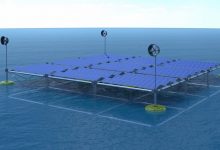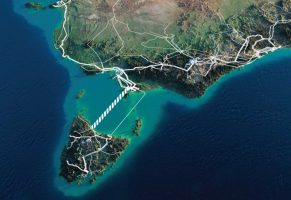German wave energy company Sinn Power is offering solar panel manufacturers the opportunity to demonstrate and test their PV modules on a floating platform in Iraklio, Greece, as part of a modular hybrid technology system that proposes to integrate renewable energy generation from waves, wind, and solar.
The Bavarian-based Sinn Power, which has been building and developing wave energy systems since 2015, is hoping to “internationalise” its ocean hybrid platform “as a complete off-grid energy solution to provide people near coasts worldwide with renewable energy.”
According to an announcement from late April, the company has developed what it believes is “an extremely robust, modular yet affordable maritime structure to generate renewable energy from waves, wind and PV.”
“Modularity has been a key aspect since we started developing maritime technologies which allows flexibility and a wide variety of applications,” said Dr.-Ing Philipp Sinn, CEO of SINN Power.
“The floating platform can supply renewable energy to island resorts in the Caribbean and contribute to the worldwide implementation of offshore wind farms. Sinn Power is the first to offer a customizable energy solution using waves, small wind and PV according to climatic conditions of any location and at competitive prices compared to other proven technologies.”
Sinn Power’s modular framework claims to be able to withstand waves up to six metres in height based on intensive long-term tests and analysis. IP68-rated electric sensors provide continuous data to diagnostic centres, in turn enabling early detection of anomalies and preventing potential failures in the structure.
The company is also able to analyse power output patterns to provide an optimised service plan for potential customers, anticipating repairs before any serious damage occurs.
“The modular design has been a key element since we started developing maritime technologies that allow flexibility and a wide variety of applications” said Sinn, speaking to Forbes earlier this month. “The floating platform can supply renewable energy to islands across the world, for example, and contribute to the worldwide implementation of offshore wind farms.”
Each floating modular unit consists of four integrated wave energy converters and can be upgraded to include an array of 20kW solar PV cells and/or up to four small 6kWp wind turbines.
“It’s always the same, it’s super modular,” said Sinn, speaking to Forbes. “We can always use the same parts, the same electronics regardless of which configuration is constructed. So, with this strategy, we want to get into volume, get the practice low, and then it’s so we can show [sic] that wave power is really attractive against solar.”
SINN Power’s plans to provide highly modular hybrid renewable energy generation is a vital demonstration of how future developers should envision their renewable energy plans. Already co-located solar and battery energy storage projects are becoming the new normal for solar generation, while co-located solar, wind, and battery energy storage projects are appearing as a potential large-scale replacement for traditional fossil fuel generation.
Hybrid renewable energy projects such as these smooth out the inherent variable generation of renewable energy technologies such as wind, solar, and wave.
Each technology generally has its own period of the day in which it generates more or less electricity, and when combined with a second or even third generation technology, and incorporated with battery energy storage, these variable generation sources become increasingly less variable.
Sinn Power’s plans to add wave energy as a potential alternative hybrid addition could be an important step forward. Laurent Albert, the CEO of Norwegian wave energy company Sebased, recently posited that “the ability to combine the power of wave and wind to stabilise energy flow to the electric grid is one of the most exciting opportunities I’ve seen since I started with marine renewable technologies, because it has the potential to be a game changer.”
In an article on the company’s website, Albert highlighted the “synergies between wave energy and offshore wind” and the potential for the two to work in concert to provide more stable generation.
“Waves are highly predictable, completely renewable, and while they are not exactly available on demand – you can’t turn them on and off at will – waves work 24/7, 365,” Albert explains. “They are accessible to the 80% of the world’s largest cities, which are in coastal areas. Moreover, they surround islands, a huge number of which currently rely on expensive and polluting imported fossil fuels.
“So, wave energy can be an accessible, renewable, CO2-free power source, for hundreds of millions of people. It’s an immense resource: the estimated theoretical global output of wave power is 29,500 TWh/yr—roughly 125% of the current global demand for electricity.
“Pairing ocean wave energy with offshore wind can be a game changer for renewable energy,” concludes.
RenewEconomy and its sister sites One Step Off The Grid and The Driven will continue to publish throughout the Covid-19 crisis, posting good news about technology and project development, and holding government, regulators and business to account. But as the conference market evaporates, and some advertisers pull in their budgets, readers can help by making a voluntary donation here to help ensure we can continue to offer the service free of charge and to as wide an audience as possible. Thank you for your support.










